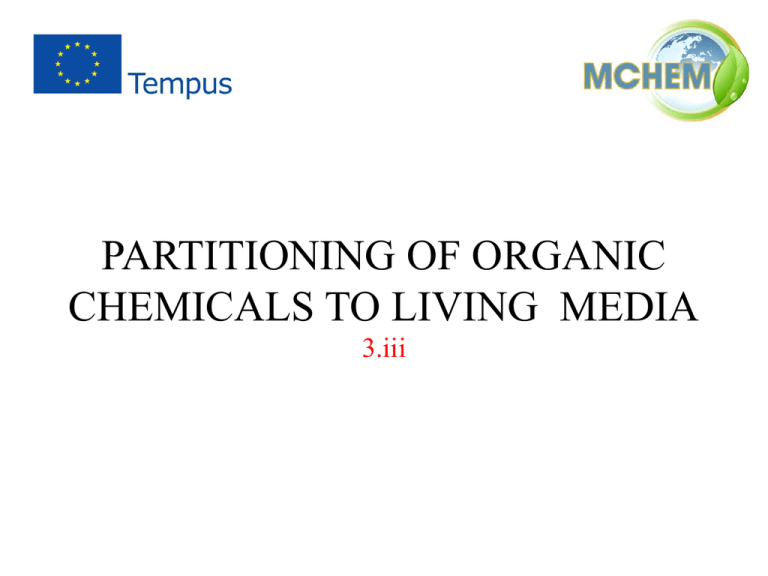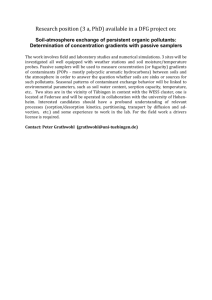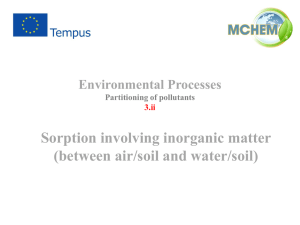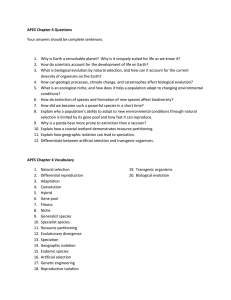partitioning of organic chemicals to living media
advertisement

PARTITIONING OF ORGANIC CHEMICALS TO LIVING MEDIA 3.iii Aims: • (i) to provide overview and terminology in sorption in living media (Biavailability; Bioaccumulation; Biomagnification) • (ii) to asses bioaccumulation and biomagnification via food web. Environmental processing / Partitioning of pollutants / Sorption in living media (bioavailability) 2 Outcomes: • students will be able to evaluate bioavailability and bioaccumulation potential of chosen pollutants based on their physico-chemical properties and environmental conditions. Environmental processing / Partitioning of pollutants / Sorption in living media (bioavailability) 3 The lecture content: • • • • Biavailability; Bioaccumulation; Biomagnification; bioacumulation of organic compounds including POPs in fish and organisms; • internal and external concentration; concept for the assessment of bioaccumulation and biomagnification via food web. Environmental processing / Partitioning of pollutants / Sorption in living media (bioavailability) 4 • The discovery that some organic chemicals, such as DDT and PCBs, were reconcentrated from the environment into organisms like birds and fish (in the early 1970s), worried many environmentally conscientious people. • The fact that bioaccumulation of chemicals might cause their transfer from the environment through food chain to higher organisms, including humans (Schemes 1 and 2), is very important for understanding how a chemical’s properties affected these transfers. • Now we know that these accumulation processes may involve: 1. direct partitioning between air and water and living media (e.g., grass, trees, phytoplankton, zooplankton); 2. more complicated sequence of transfer processes in that compounds are taken up with food and then transported internally to various parts of the organism. Environmental processing / Partitioning of pollutants / Sorption in living media (bioavailability) 5 Scheme 1. Examples of the transfer of organic pollutants from various environmental media to organisms including humans. Environmental processing / Partitioning of pollutants / Sorption in living media (bioavailability) 6 Scheme 2. Examples of the transfer of a compound i from various media to organisms including humans, by partitioning between contacting media and by food web transfers. These examples illustrate the complexity of anticipating the extent of bioaccumulation in aquatic and terrestrial food chains. Environmental processing / Partitioning of pollutants / Sorption in living media (bioavailability) 7 The Composition of Living Media • Organisms comprise a mix of organic substances. Some of these are macromolecules (e.g., globular proteins, cellulose), some combine to form subcellular and tissue “structures” built with combinations of lipids, proteins, carbohydrates, and some specialized polymers like cutin or lignin. These diverse organic materials cause organisms to have diverse macromolecular, cellular, and tissue portions that may be apolar, monopolar, and/or bipolar. • For animals, it is generally the protein fraction that predominates on the whole-organism basis, followed by carbohydrate components, and then a variable lipid content (Table 1). Since lipids serve both as ubiquitous structural components (e.g., phospholipids in membranes) and as energy reserves (especially triacylglycerides), the contributions of the total lipids may vary widely from organism to organism and tissue to tissue in the same organism. Environmental processing / Partitioning of pollutants / Sorption in living media (bioavailability) 8 Scheme 3. Examples of natural polymers relevant for sorption of organic pollutants in living media. Environmental processing / Partitioning of pollutants / Sorption in living media (bioavailability) 9 Table 1. Chemical Composition of Some Organisms (dry-weight, ash-free basis) Environmental processing / Partitioning of pollutants / Sorption in living media (bioavailability) 10 From our daily experience, we know that mammals, including humans, may exhibit quite different lipid contents, and that within one individual this lipid content may vary substantially in time. Lipids are not the only variable component in living media. In animals, proteins make the largest portion of the total body mass, but they may be secondary contributors in certain tissues (Table 1). In plants, protein content is more variable. On a dry-weight basis in phytoplankton, protein contents may range between 30% and 60%, whereas they occur at about 20% in grasses and leaves (10 – 25 %), are highly variable contributors in nuts, and are virtually absent in wood. On the other hand, the wood of vascular land plants consists primarily of lignin (~1/3) and carbohydrates, in particular cellulose and hemicellulose (~2/3). Finally, as realized by many people who watch their diet carefully, fruits like apples are rich in carbohydrates, nuts like almonds have a lot of fat, and vegetables like spinach are virtually fat-free. When considering that organic pollutants tend to partition very differently into the various organic materials of which living media are made-up, therefore, it is not surprising that concentrations of compounds expressed per total weight or volume may vary significantly for “organisms” exposed to the same environment. Hence, in order to understand how, and to what extent organic chemicals accumulate in living media, we first need to inspect how well the various biological “solvents” may accumulate such solutes. Environmental processing / Partitioning of pollutants / Sorption in living media (bioavailability) 11 Equilibrium Partitioning to Specific Types of Organic Phases Found in Organisms Table 2. Organic Phase-Water Partition Coefficients of Some Organic Compounds for Various Organic Phases: Octanol (o), Triacylglycerides (tag), Liposomes (lips), Proteins (prot), Cutin (cut), and Lignin (lig). Environmental processing / Partitioning of pollutants / Sorption in living media (bioavailability) 12 • Carbohydrates, like cellulose and chitin, have a very low tendency to accumulate organic chemicals from water. This is not too surprising considering the presence of hydroxyl moieties throughout the structures of these polymers (Scheme 3). This structural feature causes polysaccharides to interact very well with water all through their structure. Thus apolar and monopolar compounds cannot outcompete with the solvent for associations with these thoroughly bipolar polymers. In addition, some abundant carbohydrates such as cellulose and chitin tend to be crystalline in organisms; this solid state condition also discourages uptake of partitioning compounds. • Therefore, carbohydrates are considered to be of minor importance for the accumulation of organic chemicals. Environmental processing / Partitioning of pollutants / Sorption in living media (bioavailability) 13 • Compared to carbohydrates, lignin and cutin, important polymers in terrestrial plants, show a higher affinity for many organic pollutants. Small apolar and weakly monopolar molecules (chloro benzene, toluene, 1,2-dimethylbenzene) have been shown to exhibit only a slightly smaller affinity to cuticular polymer matrices than to a solvent like octanol (Table 2). Thus, the cuticular coatings on leaves are considered to be an important absorber for apolar and weakly polar hydrophobic compounds. This can be understood by noting the apolar/monopolar nature (long alkyl chains and ester groups) of cutin (Scheme 3). In the case of lignin, partition coefficients for such apolar substances are somewhat smaller (up to an order of magnitude; Table 2). Although the data are very limited, lignin-water partition coefficients appear to be more comparable to Kioc values, with Kiligw lies in the order of Kiow for the small aromatic hydrocarbons and chlorinated phenols examined to date. Environmental processing / Partitioning of pollutants / Sorption in living media (bioavailability) 14 • Due to differences in amino acid composition (R groups) and macromolecular configuration, proteins vary considerably in their ability to accommodate organic solutes. For example, the protein-water partition coefficient of the bipolar compound, 4chlorophenol, quantifying this compound’s association with bovine serum albumin (BSA) is a factor of 5 greater than its corresponding coefficient for bovine hemoglobin (BH). For the weakly monopolar compound, naphthalene, the difference is about a factor of 10 (Table 2), and a still smaller protein, myoglobin (ca. 16,000 D), does not sorb any measurable amount of naphthalene. Thus, the formation of hydrophobic domains within these protein biopolymers appears to be a key feature, allowing them to serve as sorbents of apolar and monopolar organic compounds. Environmental processing / Partitioning of pollutants / Sorption in living media (bioavailability) 15 • Lipids encompass a diverse group including apolar and polar materials. Examples of lipids that could form a primarily apolar molecular environment are the triacylglycerides (Scheme 3). Such chemical structures are common in fat storage in organisms, and hence their quantitative presence in organisms is quite variable. The triacylglycerides, triolein and tricaprylin, have been used as laboratory surrogates for mimicking the “fat” in organisms. Examples of polar lipids are the phosphatidylcholines. These are found primarily in biological membranes; hence this component of the lipid pool always exists in organisms at a relatively consistent level. • Since all lipids include hydrocarbon portions in their structures, it is not surprising that hydrophobic chemicals partition very favorably from water into such phases, much as they do into apolar organic solvents such as hexane or hexadecane. Environmental processing / Partitioning of pollutants / Sorption in living media (bioavailability) 16 A Model to Estimate Equilibrium Partitioning to Whole Organisms • Equation displayed below takes into account that organisms are heterogeneous mixtures of diverse organic phases (by assuming that each organic phase acts independently and comes to an equilibrium with all other biological phases, and the total organism accumulation of the chemical can be estimated as the sum of uptakes into each part). This equilibrium presents a whole organism-environmental medium mixed partition coefficient, Kibio: K ibio f lip * Cilip + f prot * Ciprot + f lig * G ilig + f cut * Cicut + ... Cimed Environmental processing / Partitioning of pollutants / Sorption in living media (bioavailability) 17 • forg,phase is the fraction of organism made up of the corresponding phase [lipid (lip), protein (prot), lignin (lig), cutin (cut), etc.], and is expressed, for example, as (kg org. phase kg-1 dry organism) • Corg.phase is the concentration of the compound in a given organic phase at equilibrium with the concentration in the environmental medium, and is expressed, for example, as (mol kg-1 dry phase) • Cimed is the concentration of the compound in the environmental medium (water, air, soil) considered to be in equilibrium with the organism, and is expressed, for example, as (mol L-1med or mol kg-1med) • In the literature, the estimated chemical's equilibrium concentration, Cibio, in the organism is called the theoretical bioaccumulation potential, TBPi, and is given by: Environmental processing / Partitioning of pollutants / Sorption in living media (bioavailability) 18 Parameters Used to Describe Experimental Bioaccumulation Data • • • • The term “bioaccumulation” is used to describe the total accumulation by all possible routes (passive uptake, intake by food and digestion, etc.). Parameters BCF, BMFi, BSAF present various ways of relating actual concentration, determined for a corresponding organic compound, in an organism, or organism compartment (in the lipids), to the compound’s concentration in the medium, from which the compound is thought to be primarily taken up. BAFi relates the actual concentration in the organism to the actual concentration in one medium of the environment in which the organism primarily lives. For organisms living at the sediment-water interface, Cimed is often set equal to Cis the concentration on the particulate phase, that is, BAF =BSAF. In aquatic systems, Cimed denotes the truly dissolved concentration, in the terrestrial environment this may be the truly gaseous concentration. BAFi • Ciorganism Cimed For example, animals living at the sediment-water interface can experience passive uptake of dissolved compound from water (bioconcentration) as well as uptake of the sorbed molecules on sediment particles or present in their diet (biomagnification). Environmental processing / Partitioning of pollutants / Sorption in living media (bioavailability) 19 Scheme 4. Terms and parameters frequently used to describe accumulation of chemicals in aquatic organisms. Environmental processing / Partitioning of pollutants / Sorption in living media (bioavailability) 20 Bioaccumulation in Aquatic Systems Bioaccumulation as a Dynamic Process • In the real world, equilibrium partitioning between an organism and its surroundings may not be achieved, even if a compound is not metabolized by the organism. Therefore, the observed BAFi, value may differ from the theoretical equilibrium expectation, Kibio (Eq. 10-4). In fact, because the accumulation of a given chemical may depend on several different processes occurring at the same time, BAFi may change continuously with time for a given organism. Hence, in a given natural system (a lake), even two individuals of the same species may exhibit different BAFi values. BAFi Ciorganism Cimed Environmental processing / Partitioning of pollutants / Sorption in living media (bioavailability) 21 • The accumulation of a given chemical may depend on several different processes occurring at the same time, so BAFi may change continuously with time for a corresponding organism (Scheme 5). Hence, in a given natural system, even two individuals of the same species may exhibit different BAFi values. Scheme 5. Illustration of bioaccumulation of a chemical in a fish. The various k values can be formulated as first-order rate constant for description of the kinetics dependent on the physiology and behavior of the fish. Environmental processing / Partitioning of pollutants / Sorption in living media (bioavailability) 22 • Next equation indicates that the chemical's concentration in the fish can evolve over time as the various mechanisms act simultaneously. dCi fish k1 ( K i fish Ciw Cifish ) kD ( K i fishdietCdiet ) kE ( K i fishexcret a Ciexcreta ) kMCifish kMCifish dt gill exchange uptake with food excretion growth metabolism • k1, kD, kE, kM, and kG are the first-order rate constants (dim*T-1) • Kifish, Kifishdiet, and Kifishexcreta are the equilibrium constants for partitioning of chemical i between the various combinations of fish, water, diet, and excreta. Environmental processing / Partitioning of pollutants / Sorption in living media (bioavailability) 23 Evaluating Bioaccumulation Disequlibrium Example: Biota-Sediment Accumulation Factors • Disequilibrium involves cases in which an organism is exposed to more than one environmental medium; for example, in the case for organisms living at the sediment-water interface (clams, polychaetes, amphipods, insect larvae). Hence, organisms may take up contaminants from sediments and simultaneously release them to the water column (Scheme 6.). In order to eat, such organisms often ingest particles from the sediment bed and thereby incur high exposures. In order to “breath,” these organisms must also pump water containing oxygen in and out, thus coming into intense contact with the less contaminated medium. Consequently, we may hypothesize that in such organisms, concentrations of persistent chemicals will be established that lie in between those concentrations that we would anticipate if the organism was in equilibrium with either the water column or the sediment. In other words, we would expect Ciorganism and BAFi values that are greater than predicted from equilibrium considerations involving the water, but Ciorganim BSAFi values that are smaller than the ones predicted from equilibrium with the sediment. Environmental processing / Partitioning of pollutants / Sorption in living media (bioavailability) 24 Scheme 6. Illustration of uptake and depuration of chemicals by a benthic organism, a clam dwelling near the sediment-water interface. iw is the truly dissolved compound in the water column, iPOM is the compound associated with the sediment organic matter, ipw is the compound dissolved in the sediment porewater. (POM=Solid phase organic matter) Environmental processing / Partitioning of pollutants / Sorption in living media (bioavailability) 25 Next relations present the theoretical bioaccumulation potential of lipids (TBPi) from water-sediment interface living organisms (clam), and the obtained results of organisms analysis are presented in Table 3: TBPilip (from water) = K ilipwf * Ciw TBA ilip (from sediment) = K ilipw K ioc * Cioc 0.91 PCBs : K ilipw / (L . kg -1 lip) = 3.2 x K iow BAFilip Cilip Ciw BASFilip Cilip Cioc Environmental processing / Partitioning of pollutants / Sorption in living media (bioavailability) 26 Table 3. Estimated equilibrium (Kilipw, Kilipoc) versus Measured LipidNormalized Bioaccumulation Factors (BAFilip) and Biota-Sediment Bioaccumulation Factors (BSAFilipoc) for Three PCB Congeners in Phytoplankton and Various SedimentDwelling Organisms in Western Lake Erie Environmental processing / Partitioning of pollutants / Sorption in living media (bioavailability) 27 Bioaccumulation in Terrestrial Systems • There are several facts showing that bioaccumulation of organic chemicals in terrestrial systems is more complicated than in aquatic systems. First, particularly when dealing with terrestrial plant materials, we may not a priori assume that only the lipid components predominate as the material into which the compounds partition; polymers like lignin and cutin can also be important. Second, the composition of plant materials and terrestrial animals, in which bioaccumulation measurements have been made, is often not reported. Estimates of equilibrium partition coefficients and assessments of chemical activities are not possible. Furthermore, partitioning from the gas phase (air) is strongly temperature dependent. As a consequence, seasonal fluctuations in air-plant partitioning processes are generally much more pronounced than fluctuations in partitioning coefficients involving water. • Therefore, present ability to predict bioaccumulation in terrestrial systems is still rather limited. Nevertheless, a few important general aspects can be addressed in a quantitative way. Environmental processing / Partitioning of pollutants / Sorption in living media (bioavailability) 28 Transfer of Organic Pollutants from Air to Terrestrial Biota • Presented semivolatile organic chemicals (SOCs) undergo bioaccumulation between the atmosphere and plants (partition very favorably from air into organic phase): polychlorinated aromatic hydrocarbons (DDT, DDE, DDD, HCB, PCBs), polychlorinated dibenzo-p-dioxins (PCDDs), dibenzofurans (PCDFs), as well as polycyclic aromatic hydrocarbons (PAHs). • Due to the extensive partitioning, terrestrial vegetation plays an important role in the cycling of SOCs in the environment. Certain more long-lived terrestrial plant media (lichens, moss, pine needles, and tree bark) are being used to monitor atmospheric pollution with SOCs. • Atmosphere-terrestrial plant partitioning is an important route for such compounds to enter agricultural food chains. Environmental processing / Partitioning of pollutants / Sorption in living media (bioavailability) 29 Table 4. Relating Air-Plant Partition Coefficients, Kiap, and Air-Octanol Partition Constants, Kiap of PCBs for Various Herbs and Grasses at 25°C.(Kiap values are in kg dry weight.L-1.) Environmental processing / Partitioning of pollutants / Sorption in living media (bioavailability) 30 Air-Plant Equilibrium Partitioning • The ratio of the equilibrium concentrations of organic pollutant i in the air and in the plant is defined as: Kiap = Air-Plant Partition Coefficients Kiao = Air-Octanol Partition Constants • Partition coefficients for some plants species are presented in Table 4. Environmental processing / Partitioning of pollutants / Sorption in living media (bioavailability) 31 Uptake of Organic Pollutants from Soil • Important uptake route for chemicals by terrestrial plants and organisms living in soils, is uptake from soil interstitial water, and/or by ingestion of soil particles. Uptake of contaminants from soils by certain plant species (phytoremediation) is of great interest, since it can be used to clean up contaminated sites. • The idea of phytoremediation is that compounds partition from contaminated soils into the plant roots. Subsequently, the compounds may be metabolized in the plant tissues, transported to woody tissues for storage, or transported to the leaves where the chemical can be transferred to the atmosphere. Environmental processing / Partitioning of pollutants / Sorption in living media (bioavailability) 32 Biomagnification Defining Biomagnification • Biomagnification (BMFi) - the term that describes the concentration increase of a given organic pollutant i in successive organisms along a given food chain. Scheme 7. Example of a food chain biomagnification of PCB52 (2,2’,5,5’,tetrachlorobiphenyl). Concentrations in ppb of this PCB in each “phase” of two food chains: from water to phytoplankton to herbivorous mysids to carnivorous small fish to carnivorous large fish, and from bed sediments to detrivorous amphipods to camivorous small fish to carnivorous large fish. Data from a study of Lake Ontario assuming all organisms were 80% water content to convert all concentrations to a dryweight basis. Environmental processing / Partitioning of pollutants / Sorption in living media (bioavailability) 33 BMFi, is defined as the ratio of the chemical concentration in the organism of the higher trophic level divided by the same chemical’s concentration in the organism contributing a major part of the diet BMFi can also be written in terms of the observed bioaccumulation factors of the organism considered and of its diet if both have been referenced to the same environmental medium ( Cimed): Environmental processing / Partitioning of pollutants / Sorption in living media (bioavailability) 34 Scheme 8. Average values of some organochlorine compounds concentrations (PCB 153, SDDT = o,p-DDT + p,p- DDT + o,p-DDE + p,p-DDE, SHCHs = a- + b- + d hexachlorocyclohexane, and HCB = hexachlorobenzene) in organisms belonging to some food chains (logKiow values are given in parentheses after the compound names) for three different habitats. All concentrations are expressed in pgg kg-1. Environmental processing / Partitioning of pollutants / Sorption in living media (bioavailability) 35 Biomagnification Along Terrestrial Food Chains Influence of air pressure at different temperatures on biomagnification along terrestrial food chain is presented on Scheme 9. Scheme 10 represents influence of change of seasons. Scheme 9. Environmental processing / Partitioning of pollutants / Sorption in living media (bioavailability) 36 Scheme 10. Environmental processing / Partitioning of pollutants / Sorption in living media (bioavailability) 37 References • http://www.scielo.cl/pdf/jsspn/v10n3/art05.pdf • A. Violante, V. Cozzolino, L. Perelomov, A.G. Caporale, and M. Pigna. J. Soil. Sci. Plant Nutr. 10 (3): 268 - 292 (2010) • Schwarzenbach, R.P., Gschwend, P.M., Imboden, D.M. (2003). Environmental Organic Chemistry, 2nd Edition John Wiley and Sons, New Jersey, ISBN 0-471-35750-2 • Ehlers, G.A.C. and Loibner, A.P., 2006. Environmental pollution 141, 494-512. • Fairbrother et al., 2007. Ecotoxicology and Environmental Safety 68, 145–227. Environmental processing / Partitioning of pollutants / Sorption in living media (bioavailability) 38






